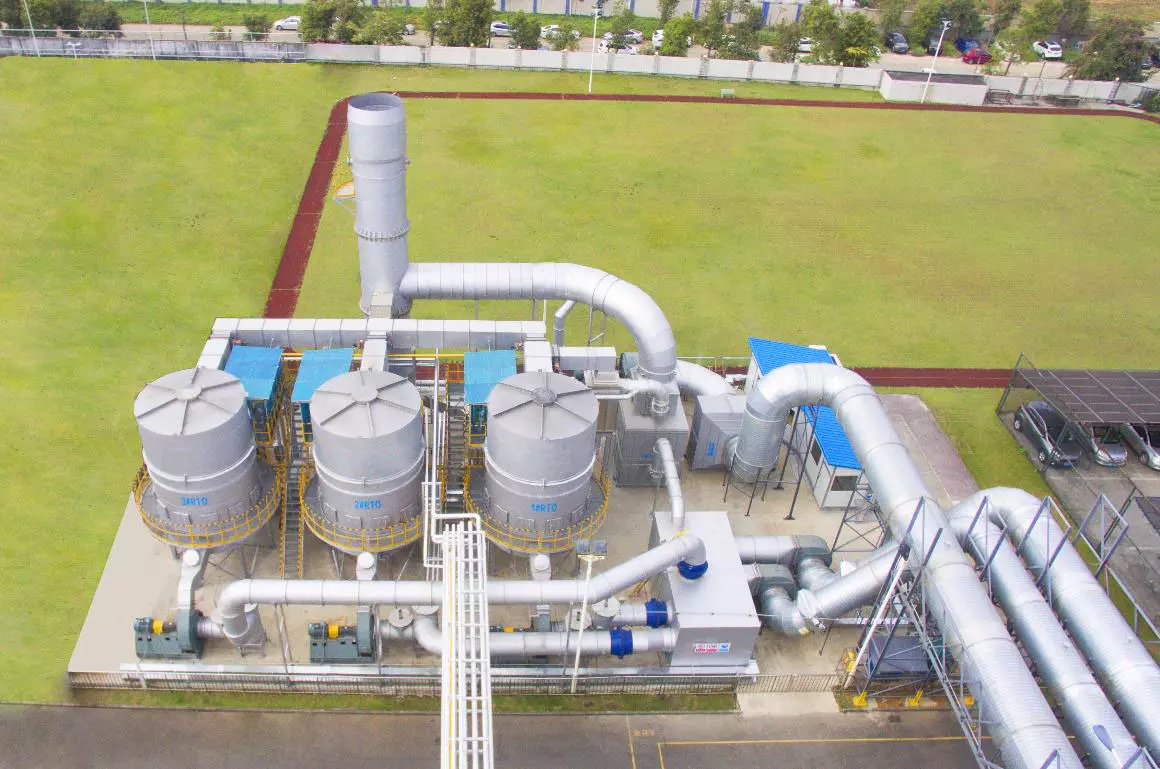recuperative thermal oxidizer for HAPs (Hazardous Air Pollutants)
Introduction
A recuperative thermal oxidizer is an effective solution for the treatment of Hazardous Air Pollutants (HAPs) in industrial processes. By utilizing high temperatures and combustion, these systems can eliminate harmful pollutants, ensuring compliance with environmental regulations. This article explores the various aspects and benefits of recuperative thermal oxidizers in addressing HAPs.
Working Principle
- Recuperative thermal oxidizers employ a two-step process: combustion and heat recovery.
- During combustion, the HAPs are oxidized, breaking them down into less harmful byproducts.
- The heat generated during this process is then captured and used to preheat the incoming polluted air stream.
- This preheating reduces the energy demand of the system, making it more efficient.
Advantages of Recuperative Thermal Oxidizers
- Effective Destruction Efficiency: Recuperative thermal oxidizers can achieve high destruction efficiencies, often exceeding 99%.
- Cost Savings: The heat recovery aspect of these systems reduces fuel consumption, resulting in significant cost savings over time.
- Environmental Compliance: By eliminating HAPs, recuperative thermal oxidizers ensure compliance with stringent air quality regulations.
- Flexibility: These systems can handle a wide range of pollutants and can be customized to suit specific process requirements.
Applications of Rekuperační tepelný oxidátors
- Coating and Printing Industries: Recuperative thermal oxidizers are commonly used in coating and printing processes to eliminate volatile organic compounds (VOCs) emitted during curing.
- Chemical Manufacturing: This technology is employed in chemical plants to treat off-gases containing various HAPs produced during chemical reactions.
- Pharmaceutical Industry: Recuperative thermal oxidizers play a crucial role in treating emissions from pharmaceutical processes, ensuring compliance with strict quality standards.
Key Components of Recuperative Thermal Oxidizers
- Heat Exchanger: The heat exchanger facilitates the transfer of heat from the hot exhaust gases to the incoming polluted air stream, maximizing energy efficiency.
- Burner System: The burner system provides the necessary heat for the combustion process, ensuring complete destruction of HAPs.
- Control Panel: The control panel allows operators to monitor and adjust the system parameters, ensuring optimal performance.
- Stack: The stack safely releases the treated air into the atmosphere after the combustion process, complying with emission regulations.
Conclusion
Recuperative thermal oxidizers are a reliable and efficient technology for treating Hazardous Air Pollutants (HAPs) in industrial processes. With their high destruction efficiencies, cost savings, and compliance with environmental regulations, these systems provide an effective solution for ensuring clean air and a sustainable future.

Introduction to Our Company
We are a high-tech equipment manufacturing company that specializes in comprehensive treatment of volatile organic compounds (VOCs) and carbon reduction and energy-saving technology. Our core technologies include thermal energy, combustion, sealing, and self-control. We have the ability to simulate temperature fields and air flow fields, model calculations, compare ceramic heat storage materials, molecular sieve adsorption materials, and test VOCs high-temperature incineration and oxidation characteristics.
We have an RTO technology R&D center and waste gas carbon reduction engineering technology center in Xi’an, and a 30,000 square meter production base in Yangling. We are a leading manufacturer of RTO equipment and molecular sieve rotary equipment in terms of production and sales volume globally. Our core technology team comes from the Aerospace Liquid Rocket Engine Research Institute (Aerospace Sixth Academy). We currently have more than 360 employees, including over 60 R&D technology backbones, among which there are 3 research fellows, 6 senior engineers, and 69 thermodynamics doctors.
Our core products are rotating valve-type heat storage oxidation incinerators (RTOs) and molecular sieve adsorption and concentration rotary wheels. With our own environmental protection and thermal energy system engineering expertise, we can provide customers with comprehensive solutions for industrial waste gas treatment and thermal energy utilization carbon reduction.
Certifikace, patenty a vyznamenání
Our company has obtained various certifications and qualifications, such as knowledge property management system certification, quality management system certification, environmental management system certification, construction industry enterprise qualification, high-tech enterprise, rotating heat-storage oxidation furnace turning valve patent, rotary heat storage incineration equipment patent, and disc-type molecular sieve rotary wheel patent, etc.

How to Choose the Right RTO Equipment
- Determine the characteristics of waste gas.
- Understand the local regulations and emission standards.
- Evaluate energy efficiency.
- Consider operation and maintenance.
- Conduct budget and cost analysis.
- Select the appropriate type of RTO.
- Consider environmental and safety factors.
- Perform performance testing and validation.
It is important to thoroughly explain each point when selecting RTO equipment.

Our Service Process
- Consultation and evaluation: initial consultation, site inspection, needs analysis.
- Design and plan development: scheme design, simulation and modeling, scheme review.
- Production and manufacturing: customized production, quality control, factory testing.
- Installation and debugging: on-site installation, commissioning, training services.
- After-sales support: regular maintenance, technical support, spare parts supply.
We are a one-stop solution provider with a professional team that can tailor RTO solutions to customer needs.
Autor: Miya
